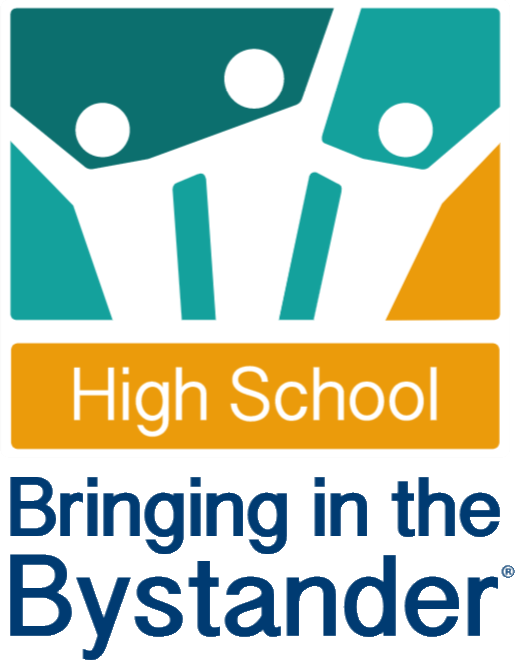
Bringing in the Bystander for a better & safer high school community
BUILDING SAFE AND RESPECTFUL LEARNING COMMUNITIES
Bringing in the Bystander® High School Prevention Program is an innovative program adapted from the acclaimed Bringing in the Bystander College Prevention Program, based on decades of research on bystander intervention.
The program sets the standard for bystander intervention training as it incorporates a community of responsibility model rather than narrowly focusing on victims and perpetrators. In this model, all community members have a role as active bystanders in ending incivility, harassment, discrimination and violence, including sexual violence.
High school participants gain the knowledge and skills needed to identify and safely intervene before, during, and after instances of risky behaviors. This includes developing and practicing bystander intervention prevention skills, learning prosocial (positive, appropriate, and safe) ways to effectively intervene.

An Evidence-Based Program
Bringing in the Bystander® High School Prevention Program has been adapted from the acclaimed Bringing in the Bystander College Prevention Program, based on decades of groundbreaking research by the University of New Hampshire’s acclaimed Prevention Innovations Research Center. This research led to developing the Bringing in the Bystander College program, incorporating the most effective strategies for students to prevent and react to undesirable situations and scenarios on campus and throughout the community.
To learn more about bystander intervention research, click here.

Evaluation of Bringing in the Bystander Prevention Program:

Bringing in the Bystander (BITB) College was evaluated and demonstrated to be an effective prevention program, satisfying many grant requirements. Evaluations (Moynihan et al. 2015, Cares et al. 2015, Peterson et al. 2016) were funded by The National Institute for Justice, the Centers for Disease Control and Prevention, and the US Department of Justice.
The High School program was adapted from the College curriculum and included extensive evaluation from 26 high schools funded by the Centers for Disease Control and Prevention (CDC). The evaluation findings (Edwards et al. 2019) included:
- Students exposed to the high school curriculum demonstrated significant short-term changes in victim empathy.
- Promising reduction in sexual harassment and stalking.
- The curriculum significantly reduced rape myths and bystander barriers.
- Long-term effect of increased media literacy and bystander readiness.
BRINGING IN THE BYSTANDER HIGH SCHOOL PREVENTION PROGRAM – AN OVERVIEW

This interactive program allows participants to develop and practice bystander intervention prevention skills in-person or virtually. BITB approaches all community members as potential bystanders or witnesses to risky situations and teaches prosocial (positive, appropriate and safe) ways to prevent or intervene.
Learning Methods

Lecture

Discussion

Interactive Exercises

Small Group Work

Opportunities to Practice Skills

Role Play Scenarios
BITB High School Curriculum Comparisons by License Level
| Partner | The Bundle | |
|---|---|---|
| 3-Year Curriculum License (v1.23) | $1,600 | $1,900 |
| Know Your Power® High School Posters* |
 |
 * * |
| Facilitator Guide for relevance and time management 2 Copies |  |
 |
| Facilitator Training Videos |  |
 |
| Curriculum PowerPoint, Electronic Templates, and Resources |  |
 |
| Access to Soteria Solutions High School Online Community (schools and community partners) |  |
 |
| Virtual Webinars with Soteria Solutions professionals and trainers to discuss, share and learn |  |
 |
| Bystander Intervention Social Media Toolkit |  |
 |
*Included with The Bundle is 50 posters of the Know Your Power High School marketing campaign. You choose up to two images (25 posters per scenario).
Additional offering
Consulting services for successful implementation, adaption and evaluation of BITB. $200/hour.
Training Options
In addition to the virtual office hours, Soteria Solutions offers three training options for community partners, teachers, and students to facilitate BITB for your high school community. Participants will learn the BITB curriculum in depth and be empowered to train future facilitators within your high school community.
Participants for a high school implementation typically include community partners, high school teachers, counselors, coaches, staff, and students who are responsible for coordinating and/or facilitating sexual assault prevention and similar programs at the high school and in the community.
Join Training |
Host Training |
Small Group Refresher Session |
|
|---|---|---|---|
| FORMAT | In person or live virtual | In person or live virtual | Live virtual |
| DURATION | 1 day for in person; virtual is total of 7 hours split over two days |
1 day for in person; virtual is total of 7 hours split over two days |
2 hours includes option to schedule one 2-hr session or two 1-hour sessions. |
| DETAILS | Ideal for training members of your community as we can train up to 40 participants. This option provides an excellent opportunity to learn from participants from other high school communities. Typically offered two times per year. |
This option offers the chance for a community to train many people at once (min. of 12 for virtual and 20 for in-person). Training materials are customized, including scenarios to resonate with the participants. This option can enable a cohesive, effective, and successful implementation. | A virtual refresher session for up to 5 facilitators- designed to update and enhance the skills and knowledge of experienced facilitators. The session aims to ensure that facilitators are up-to-date with the latest practices, techniques, and information around BITB relevant to their roles, thereby maintaining high standards of facilitation and effective student engagement. Customized to the audience and college community. Ideal for attendees who have relevant prevention and facilitation experience. |
| PRICING | $475 pp for in person; $400 pp for virtual |
$475 pp for in person; $400 pp for virtual |
$1,200 for up to five attendees; $300 pp for additional attendees |
| What training option is the best for your organization? | Click here for a High School BITB Training Guide on Joining or Hosting Training | Click here for a High School BITB Training Guide on Joining or Hosting Training | Contact us to discuss Small Group Refresher Course |
WHY SOTERIA SOLUTIONS FOR YOUR HIGH SCHOOL?
- Solutions customized to leverage your high school's strengths, culture, and values.
- A collaborative, flexible approach as we partner with you as a catalyst to ignite lasting change.
- Bringing in the Bystander® is based on leading research on bystander intervention.
- Bringing in the Bystander was evaluated and demonstrated to be an effective prevention program, satisfying many grant requirements.
- Sustainable change is achieved by improving organizational frameworks (e.g., goals, core values, reporting mechanisms, cultural norms) essential to making strategic shifts.
- The program, adapted for high schools, is based on the College Prevention Program that is nationally recognized by Centers for Disease Control and Prevention (CDC), Culture of Respect, and The White House Task Force to Protect Students from Sexual Assault as a theory-driven and evidence-based sexual violence prevention program.
- Skilled trainers with many years of sexual violence prevention experience lead these trainings. The High School Prevention Program was developed by two of our trainers. Learn more about Caroline Leyva and Bobby Eckstein.
Other Solutions for High Schools
Download an overview of Soteria Solutions’ High School Bringing in the Bystander program to share with colleagues.
Bringing in the Bystander is a very strong curriculum - it is youth-centered and visually appealing without being cheesy, and provides great support for facilitators through scripts, training, and helpful hints. It also provides multiple opportunities in each module to make the curriculum relevant and tailored to a more specific audience or communities. The content is comprehensive and in-depth, but also manageable enough that students would not feel overwhelmed by the content or need much prior knowledge to comprehend the lessons.
- Superintendent of Public Instruction, Washington State






